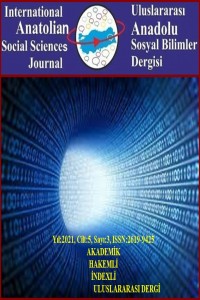A BRIEF OVERVIEW OF SEXUALITY IN THE ART OF WESTERN PAINTING IN THE CONTEXT OF BALTHUS’S “GIRL WITH THE CAT”
Abstract
Balthhus is one of the most remarkable figures in Western painting. He is a recluse devoted to God, who did not give up the classicism that he adopted throughout his life despite the radical transformations that took place in the art of painting, which he witnessed throughout his long life. It is the success of pointing out one of the unsolved problems of modern people with the contrary content in his paintings, which makes it still debatable today. This unsolved and suppressed problem is the phenomenon of sexuality. The history of art is full of many examples, most of which are from westtern art, that convey in a creative way the contradiction and confusion experienced by people who find it difficult to adapt their biology to their developing society. The purpse of this text is to contribute to the healthy evaluation of the works Balthus gave in the first half of the 20th century, within sections from the history of art.
Keywords
References
- Hançerlioğlu, O. (1995). Düşünce Tarihi. İstanbul: Remzi Kitabevi. Klossowski, S. (1996). Balthus. London: Thames and Hudson Ltd. Montanari, M. (1995). Avrupa’da Yemeğin Tarihi. İstanbul: Afa Yayınları. Oranlı, İ. (2009). 19. YY. Avrupası’nda Irkçılık ve Cinsiyetçilik, Cogito. 58, 339-350. Passeron, R. (2000). Sürrealizm Sanat Ansiklopedisi. İstanbul: Remzi Kitabevi. Şimşek, A. (2005). Yeni Orta Sınıf. İstanbul: Epokhe Yayınevi.
- Vircondelet, A. (2012). Balthüs’ün Anıları. İstanbul: Yapı Kredi Yayınları.
- Taylor, S. (2005)."A Shine on the Nose'': Sexual Metaphors in Surrealism, Portland State University, Oregon.
- Mary Magala Ward’ın The Virtues and Dangers of Connecting Art to Life: Can Pragmatism Address Balthus
- Morris, D. Koruyucu Tılsımlar, Ankara: İnkılap Yayınevi.
- Genzmer, H. Gala ve Dali. İletişim Yayınları, 2000. Ankara
- Weber. M. Protestan Ahlakı ve Kapitalizmin Ruhu. Oda Yayınları, 2019. İstanbul.
- Güvenç, B. İnsan ve Kültür. Boyut Yayıncılık, 2016. İstanbul.
- Leppert, R. Sanatta Anlamın Görüntüsü. Ayrıntı Yayınları, 2009. İstanbul.
- Néret, G. Balthus: The Kings of Cats. Tachen, 2003. Köln.
BALTHUS’UN “KEDİLİ KIZ” ADLI ESERİ BAĞLAMINDA BATI RESİM SANATINDA CİNSELLİK OLGUSUNA KISA BİR BAKIŞ
Abstract
Balthus, Batı Resim sanatının en dikkat çekici isimlerinden biridir. Uzun yaşantısı boyunca tanıklık ettiği, resim sanatında gerçekleşen köklü dönüşümlere karşın tüm hayatı boyunca benimsediği klasisizmden vazgeçmeyen, sanatı Tanrıya adanmış bir münzevidir Balthus. Dönemi için O’nu aykırı kılan, hiç taviz vermediği klasik biçimciliğiyse, günümüzde hala tartışılır olmasını sağlayan resimlerindeki aykırı içerikle modern insanın çözümsüz kalan sorunlarından birine işaret etmekteki başarısıdır. Bu çözümlenememiş, bastırılmış sorun cinsellik olgusudur. Resim sanatı tarihi -büyük bölümü batı sanatından olmak üzere- biyolojisini gelişen toplumsallığına uydurmakta zorlanan insanın yaşadığı çelişkiyi ve karmaşayı yaratıcı bir yolla aktaran çok sayıda örnekle doludur. Bu metnin amacı, sanat tarihinden kesitlerle Balthus’un 20. Yüzyılın ilk yarısında verdiği eserlerin değerlendirmesinin yapılmasına katkı sunmaktır.
Keywords
References
- Hançerlioğlu, O. (1995). Düşünce Tarihi. İstanbul: Remzi Kitabevi. Klossowski, S. (1996). Balthus. London: Thames and Hudson Ltd. Montanari, M. (1995). Avrupa’da Yemeğin Tarihi. İstanbul: Afa Yayınları. Oranlı, İ. (2009). 19. YY. Avrupası’nda Irkçılık ve Cinsiyetçilik, Cogito. 58, 339-350. Passeron, R. (2000). Sürrealizm Sanat Ansiklopedisi. İstanbul: Remzi Kitabevi. Şimşek, A. (2005). Yeni Orta Sınıf. İstanbul: Epokhe Yayınevi.
- Vircondelet, A. (2012). Balthüs’ün Anıları. İstanbul: Yapı Kredi Yayınları.
- Taylor, S. (2005)."A Shine on the Nose'': Sexual Metaphors in Surrealism, Portland State University, Oregon.
- Mary Magala Ward’ın The Virtues and Dangers of Connecting Art to Life: Can Pragmatism Address Balthus
- Morris, D. Koruyucu Tılsımlar, Ankara: İnkılap Yayınevi.
- Genzmer, H. Gala ve Dali. İletişim Yayınları, 2000. Ankara
- Weber. M. Protestan Ahlakı ve Kapitalizmin Ruhu. Oda Yayınları, 2019. İstanbul.
- Güvenç, B. İnsan ve Kültür. Boyut Yayıncılık, 2016. İstanbul.
- Leppert, R. Sanatta Anlamın Görüntüsü. Ayrıntı Yayınları, 2009. İstanbul.
- Néret, G. Balthus: The Kings of Cats. Tachen, 2003. Köln.
Details
| Primary Language | Turkish |
|---|---|
| Journal Section | Articles |
| Authors | |
| Publication Date | August 5, 2021 |
| Submission Date | April 22, 2021 |
| Published in Issue | Year 2021 Volume: 5 Issue: 3 |
Our journal licensed under a Creative Commons Attribution-NonCommercial 4.0 International License


